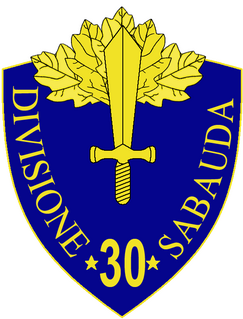History
As the war become imminent, the 25th divisional artillery regiment was sent in September, 1935 to Libya, and transferred to Eritrea in March 1936, to fight within the newly formed Assietta Infantry Division II (126a) which was dissolved later in 1937.
The Assietta division itself, receiving a 49th divisional artillery regiment instead of the missing 25th, landed in Massawa in January 1936. Soon it reached the Endaga Robo-Enticho-Dek’emhāre region. Then it moved its headquarters to Mek'ele, guarding a front from Doghea to Kwīhā. The Assietta division participated in the Battle of Amba Aradam in February 1936, fighting mostly in defence. Some detachments of Assietta division were used to reinforce the left flank of the 27th Infantry Division Sila. On 2 March 1939, it blocked a retreat route of the Ethiopian army on the front from Yereserē to Edai. But the retreating Ethiopian army bypassed the Asietta division, breaking through Italian lines further to the east in their push to Amba Alagi. The Assietta division, now used as a rear areas guard force, followed in March–April 1936 first to Aderat and Amba Alagi and then to Atzalo and Aiba. After the conclusion of war, it was used in June 1936 for mopping-up south of Lake Ashenge. In July 1936 it was transferred to an unidentified location, "Seggiù". The last duty assignment was in September 1936 to the city of Dessie. The orders to return to Italy were received 2 February 1937.
Second World War
Following return to Italy, the Assietta division was placed in Latina, Lazio in March 1937, where it received back the 25th artillery regiment. Several reorganizations and detachments followed, until 5 April 1939, when the form of the new Assietta division was settled. The newly reorganized division took part in the Italian invasion of France. It was then involved in the Invasion of Yugoslavia and soon after moved to Sicily. It was destroyed during the Allied landings.
At the start of April, 1941, the Assietta division was in the border town of Ajdovščina. On 6 April 1941, it moved to defensive positions at Javornik, Idrija. After the failure of the Yugoslavian army the division moved its headquarters to Delnice 20 April 1941, performing for a while mopping-up operations in the Gerovo-Karlovac-Lokve, Croatia region. As operations had been wrapping up, the division moved to Ilirska Bistrica on 6 May 1941 before departing for Italy 15 May 1941.
Defence of Sicily
The location of Assietta division changed during the first half of August 1941 to the western part of Sicily island as part of XII army corps. Initially, the headquarters were located in Caltanissetta, and the coastal defence sector stretched from Porto Empedocle to Licata. On 10 July 1943, the day of the Allied invasion of Sicily, the division was in the Santa Ninfa-Partanna area in the west of Sicily, but started marching to Licata immediately. By the time the division was able to make contact with the enemy, the rapid Allied advance resulted in battles in the Lercara Friddi area. Unable to cover the wide front against the numerous Allied troops, on 15 July 1943 the Assietta division had to split into three roadblock groups near Bisacquino, blocking routes from Agrigento to Palermo. Unfortunately, the rapid crumbling of Italian defences elsewhere meant that a defensive line to be abandoned on 16 July 1943. The division then fell back to the Cerda-Chiusa Sclafani line. Unlike other Italian units nearby, it maintained constant contact with the enemy, constantly setting up delaying battles. An attempt was made to make a stand 22 July 1943, but by the late evening 23 July 1943, the Allies had made a breakthrough, resulting in an Italian run to Santo Stefano di Camastra. On 29 July 1943, the division fought at the San Fratello-Troina line. The nearby Battle of Troina was over on 6 August 1943, and United States units turned their forces to the battered Assietta division again. The initial armor attack to San Fratello and mount Pizzo degli Angeli was repulsed, but on 7 August 1943, the Assietta had to fall back to Tortorici after the Allies made a landing at the division's rear in the Militello Rosmarino. By this time the division was severely crippled by heavy casualties and unfit for battle. The remains of it stayed in the Messina area 11–14 August 1943, before being evacuated to the mainland.

The 29th Infantry Division Piemonte was an infantry division of the Royal Italian Army during World War II. Originally raised with the name 29th Infantry Division Peloritani, the division fought in Ethiopia during the interwar period. The division was reorganized as the binary 29th Infantry Division Piemonte on 15 April 1939, and fought in Greece. Initially garrisoned in Messina, Sicily, the division was made up entirely of Sicilians.

The 30th Infantry Division Sabauda was an infantry division of the Royal Italian Army during World War II.

The 24th Infantry Division Pinerolo was an infantry division of the Italian Army during World War II.
The 2nd CC.NN. Division "28 Ottobre" was an Italian militia division, formed to participate in the Italian Second Italo-Abyssinian War against Ethiopia in the mid-1930s.

1st Infantry Division Superga was a mountain infantry division of the Italian Army during World War II. It was formed in 1940 in Torino (Turin), and was part of the 4th Army, Italian I Corps during the Italian invasion of France. The only difference between line infantry divisions and mountain infantry divisions was that the latter's artillery was carried by pack mules instead of the standard horse-drawn carriages. Italy's real mountain warfare divisions were the six alpine divisions manned by the "Alpini" mountain troops.

The 33rd Infantry Division Acqui was a mountain infantry Division of the Italian Army during World War II. The only difference between line infantry divisions and mountain infantry divisions was that the latter's artillery was carried by pack mules instead of the standard horse-drawn carriages. Italy's real mountain warfare divisions were the six alpine divisions manned by the "Alpini" mountain troops. The Acqui Division was formed in August 1939 from the parts of 14th and 11th infantry brigades, and mobilized for war in October 1939. It is notable for having been massacred with remarkable cruelty after surrendering to the Germans on 21 September 1943. The main detachments of the Acqui division in the islands of Cephalonia and Corfu were officially dissolved 24 September 1943.

The Infantry Division "Friuli" was a division of the Italian Army active in World War II and during the early days of the Cold War.

The 31st Infantry Division Calabria was an infantry division of the Italian Army during World War II. The Calabria Division, formed from the 31st Infantry Brigade "Caprera" 15 October 1939, was part of the garrison at Sardinia where it remained until it surrendered to the Allies after the Italian surrender in September 1943. The Division would then serve on the Allied side until the end of the war.

The 37th Infantry Division Modena was a mountain Infantry Division of the Italian Army during World War II. It was formed 25 March 1939, from the parts of the Territorial Division Imperia 5a. It was made up entirely of men from Genoa and Liguria. The only difference between line infantry divisions and mountain infantry divisions was that the latter's artillery was carried by pack mules instead of the standard horse-drawn carriages. Italy's real mountain warfare divisions were the six alpine divisions manned by the "Alpini" mountain troops.

The 38th Infantry Division Puglie was a mountain infantry division of the Italian Army during World War II. The Puglie Division was mobilized 15 May 1939 and disintegrated soon after 8 September 1943. The division filled its ranks with men drafted in eastern Veneto and Friuli, with a majority of soldiers hailing from the towns of Sacile and Vittorio Veneto. The only difference between line infantry divisions and mountain infantry divisions was that the latter's artillery was carried by pack mules instead of the standard horse-drawn carriages. Italy's real mountain warfare divisions were the six alpine divisions manned by the "Alpini" mountain troops.

The 40th Infantry Division "Cacciatori d’Africa" was an infantry division of the Italian Army during World War II. It was formed 27 July 1940 and dissolved 15 May 1941. The divisions Cacciatori d’Africa and 65 Infantry Division Granatieri di Savoia were outside of the normal chain of command, being subordinated directly to Prince Amedeo, Duke of Aosta., together with other colonial troops in Italian East Africa.

The 59th Infantry Division Cagliari was a mountain infantry division of the Italian Army during World War II. It was formed 5 April 1939 in Vercelli and dissolved 8 September 1943 in southern Peloponnese. Garrisoned in Vercelli, the division was made up almost entirely of men from northern Piedmont, especially from Vercelli and Ivrea. The only difference between line infantry divisions and mountain infantry divisions was that the latter's artillery was carried by pack mules instead of the standard horse-drawn carriages. Italy's real mountain warfare divisions were the six alpine divisions manned by the "Alpini" mountain troops.

The 65th Infantry Division "Grenadiers of Savoy" was an infantry division of the Italian Army during World War II. It was created 12 October 1936 in Littoria (Latina) and was officially dissolved 20 April 1941 in Soddu, Ethiopia.

The 44th Infantry Division Cremona was an infantry division of the Italian Army during World War II.

The 49th Infantry Division Parma was an infantry division of the Italian Army during World War II. The Parma Division was a regular division of the Italian Army, formed 12 September 1939 in Macerata, and dissolved 8 September 1943 in Vlorë.

The 50th Infantry Division Regina was an infantry division of the Italian Army during World War II. The Regina Division was a regular division of the Italian Army. It was formed on 1 March 1939 in the Italian Islands of the Aegean and formally dissolved in the same place 11 September 1943, although some sub-units continued to fight until 16 November 1943.

The 51st Infantry Division Siena was a regular infantry division of the Italian Army during World War II. The Siena Division was formed 15 September 1939 and dissolved 8 September 1943. Historically a Campanian unit, it was made almost entirely of Neapolitans.

The 53rd Infantry Division Arezzo was a mountain infantry division of the Italian Army during World War II. It was formed 24 May 1939 and officially dissolved 12 September 1943. The Arezzo division is not related to partisan division Arezzo operating in 1943 in the Cortona vicinity under command of Siro Rossetti. The only difference between line infantry divisions and mountain infantry divisions was that the latter's artillery was carried by pack mules instead of the standard horse-drawn carriages. Italy's real mountain warfare divisions were the six alpine divisions manned by the Alpini mountain troops.

The 54th Infantry Division Napoli was a regular infantry division of the Italian Army during World War II. It was created 15 April 1939 in Caltanissetta and was dissolved 14 August 1943 in Melia southeast of Scilla, Calabria after being nearly wiped out in the Allied invasion of Sicily. The division drafted men in southern Sicily. The members of the division hailed from Caltanissetta, Agrigento, Syracuse and surrounding territories.
This page is based on this
Wikipedia article Text is available under the
CC BY-SA 4.0 license; additional terms may apply.
Images, videos and audio are available under their respective licenses.




















